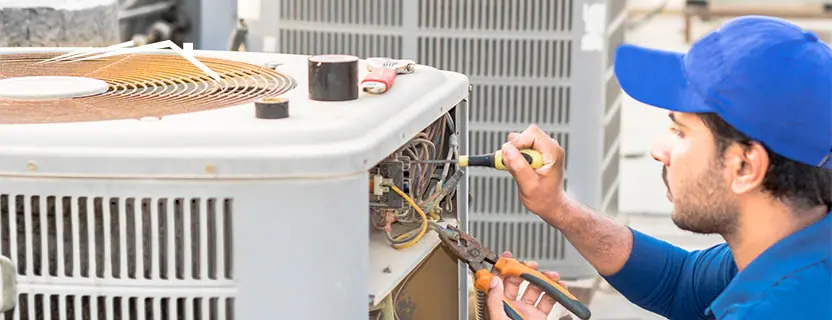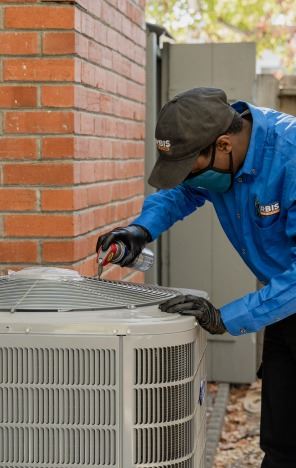5 Must-Know Facts About ductless mini splits Before You Upgrade
Exactly How a Warmth Pump and Heater Job Together to Maximize Your Home's Heating Efficiency
Understanding just how a heatpump and heating system collaborate is crucial for home owners looking for effective heating remedies. Each system has its toughness, offering a balanced strategy to home convenience. The heatpump masters modest temperatures, while the furnace supplies quick heat during severe cold. This synergy not just minimizes power prices but additionally improves the life-span of both home appliances. What variables influence this collaboration, and how can home owners maximize their advantages?
Comprehending Warmth Pumps: Just How They Work
Several individuals might be unknown with their inner workings, warm pumps play a vital role in modern home heating systems. These tools operate by moving warm from one area to an additional, making use of the principles of thermodynamics. In cooler months, a heatpump essences warm from the outside air, ground, or water, and transfers it inside your home to warm up the living space. Alternatively, during warmer months, it can reverse the procedure, working as an air conditioning unit by getting rid of warm from inside to the outside.Heat pumps include an evaporator, development, compressor, and condenser shutoff. The cooling agent within the system takes in warm as it vaporizes at reduced temperature levels and stress. The compressor after that raises the stress and temperature level of the cooling agent, allowing it to launch warmth as it condenses. This effective procedure can greatly decrease energy intake contrasted to conventional heating approaches, making heatpump a lasting selection for environment control in homes.
The Duty of Heaters in Home Heating
Heating systems play a crucial function in home heating by giving a reputable resource of warmth throughout the chillier months. They run by generating warmth with burning or electrical resistance, dispersing it throughout the home by means of air ducts or radiant systems. The performance of a heating system is usually measured by its Yearly Fuel Utilization Effectiveness (AFUE) rating, which indicates just how properly the device converts fuel into heat.Furnaces can use various power resources, consisting of all-natural gas, electrical energy, oil, or propane, enabling property owners to choose one of the most suitable choice for their requirements. Unlike warm pumps, which might have a hard time in extreme chilly, furnaces preserve consistent efficiency, ensuring that interior temperature levels stay comfortable despite exterior problems. Additionally, contemporary heaters typically come geared up with advanced innovation, such as variable-speed blowers and clever thermostats, improving their performance and responsiveness. This adaptability makes heating systems an essential element in comprehensive home heating strategies.

Advantages of Utilizing Both Solutions Together
Combining the toughness of both heaters and warm pumps can bring about an extra effective and effective home heating remedy. Using both systems permits home owners to take benefit of the warm pump's energy performance throughout milder temperature levels while relying upon the heater for even more extreme cold conditions. This twin approach can considerably decrease power expenses, as warmth pumps consume less electrical power than conventional heating techniques when temperatures are moderate.Additionally, using both systems with each other can boost convenience levels in the home. Heat pumps can give constant, even heating, while furnaces can quickly elevate ambient temperature levels when needed. Furthermore, the integration of both systems can prolong the lifespan of devices by decreasing deterioration on each unit, as they share the work. Ultimately, property owners can take pleasure in a well balanced, cost-efficient heating service that readjusts flawlessly to varying weather conditions, making certain a cozy and inviting home throughout the winter months.
Just How Warm Pumps and Furnaces Enhance Each Various Other
When homeowners integrate heatpump and heaters, they produce a complementary heating system that makes best use of performance and convenience. Warmth pumps run by transferring warm from the outside air or ground, making them extremely effective in moderate climates. They excel throughout milder temperature levels, providing affordable heating. Alternatively, furnaces generate warmth via burning or electric resistance, delivering strong, prompt heat throughout extreme cold conditions.The combination of these two systems enables vibrant changes based upon temperature level variations. Throughout warmer months or milder winter months days, the heatpump can take the lead, conserving power and lowering costs. As temperature levels decrease, the furnace can seamlessly involve, making sure constant warmth throughout the home. This harmony not only maximizes energy usage but likewise improves the lifespan of both systems, as each unit operates within its suitable efficiency variety. Together, they create a well balanced environment that adapts to differing environment demands.
Enhancing Efficiency: Tips for Homeowners
Property owners can enhance their home heating effectiveness via several useful methods. Developing a regular maintenance routine, integrating clever thermostat innovation, and executing effective insulation and securing solutions are vital steps. These measures not just improve convenience however also lower energy prices.
Normal Upkeep Schedule
To ensure optimal heating performance, establishing a normal maintenance routine is essential for any kind of home. Property owners need to prioritize regular inspections of both heatpump and heating systems to ascertain peak performance. This includes changing air filters each to 3 months, as clogged filters can substantially minimize effectiveness. Furthermore, scheduling professional maintenance at the very least once a year allows professionals to determine and address prospective issues prior to they escalate. House owners ought to also clean the heat pump's outdoor system to avoid debris accumulation that can impede airflow. By adhering to a normal upkeep schedule, home owners not only improve their heating systems' effectiveness but additionally extend their life-span, bring about better convenience and reduced energy costs throughout the cooler months.
Smart Thermostat Combination
Integrating a wise thermostat into a home heating system can significantly boost energy efficiency, especially as it enables exact control over temperature settings. These tools can discover the homeowner's timetable and choices, immediately changing the temperature level to optimize convenience while lessening energy use. For example, they can reduce heating during times when the home is vacant, minimizing unnecessary intake. Numerous clever thermostats additionally supply real-time power usage data, allowing homeowners to make informed choices concerning their home heating practices. Additionally, remote gain access to by means of smartphone apps enables users to adjust setups from anywhere, making sure the home is cozy upon return. Generally, clever thermostat assimilation not only improves convenience yet significantly adds to power financial savings and efficiency.
Insulation and Sealing Solutions
Smart thermostats play a crucial duty in energy performance, however their effectiveness can be greatly boosted by appropriate insulation and sealing options. Home owners ought to focus on insulating attics, wall surfaces, and floorings to reduce heat loss. High-grade insulation materials, such as spray foam or fiberglass, can significantly enhance thermal resistance. In addition, securing voids around ducts, home windows, and doors protects against cold air seepage and heat getaway. Weatherstripping and caulking work approaches for addressing these leaks - furnace replacement. Regular evaluations for air leakages, together with making use of blower door tests, can help identify problem areas. By purchasing insulation and you can check here sealing, house owners can enhance the efficiency of their heating unit, eventually resulting in lowered power consumption and reduced energy expenses
Usual Myths Concerning Warm Pumps and Furnaces
What misconceptions border warm pumps and heaters? Numerous people mistakenly think that warmth pumps are ineffective in colder climates. Actually, contemporary warmth pumps are made to run successfully even in reduced temperature levels, supplying reliable home heating throughout winter season. An additional usual myth is that heating systems are always much more effective than heatpump. Nonetheless, this depends upon the certain energy resources and efficiency scores of the units concerned. Some may additionally assume that using both systems at the same time is unneeded, however as a matter of fact, this combination can maximize home heating efficiency, especially throughout extreme climate conditions. In addition, people usually think that warm pumps require continuous upkeep, when in reality, they have comparable maintenance requires to conventional heating unit. By unmasking these misconceptions, homeowners can make even more informed choices concerning their home heating alternatives, ultimately resulting in enhanced convenience and energy efficiency in their homes.
Maintenance Considerations for Combined Systems

Frequently Asked Concerns
Can Warmth Pumps Job Successfully in Extremely Cold Climates?
Warm pumps can battle in extremely cool climates as a result of reduced effectiveness and warm removal constraints. However, improvements in modern technology have caused versions developed for better efficiency in such conditions, enhancing their practicality in extreme settings.
How Much Time Do Heat Pumps and Furnaces Generally Last?
Warmth pumps typically last 15 to 20 years, while furnaces have a life expectancy of 15 to three decades. Normal upkeep can expand their long life, ensuring effective operation and decreasing the requirement for premature replacements.

What Is the Ordinary Expense of Setting Up Both Systems?
The typical price of installing both a heatpump and a heating system typically varies between $5,000 to $10,000 - heat pump service. Variables influencing this price include system dimension, installation complexity, and local labor rates
Are There Tax Obligation Motivations for Utilizing Energy-Efficient Home Heating Solutions?
Many home owners ask about tax motivations for energy-efficient heating systems. Different government and additional reading state programs frequently use credits or refunds, motivating the fostering of sustainable technologies to reduce energy consumption and advertise environmental responsibility.
Just how Do I Pick the Right Dimension Heatpump and Heating System?
Picking the right size warm pump and heating system entails calculating the home's square video footage, thinking about insulation top quality, and examining neighborhood climate. Consulting a professional can ensure suitable system performance and power performance based upon specific needs. heat pump service. Recognizing just how a warm YOURURL.com pump and heating system work with each other is essential for house owners seeking effective home heating services. In chillier months, a warmth pump removes warmth from the outdoors air, ground, or water, and transfers it inside to heat the living area. When property owners integrate heat pumps and heating systems, they produce a corresponding heating system that makes best use of performance and convenience. Warm pumps operate by moving heat from the outside air or ground, making them highly efficient in moderate climates. Warmth pumps can battle in incredibly cold environments due to lowered performance and warm extraction restrictions